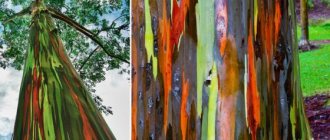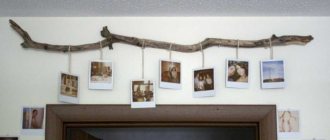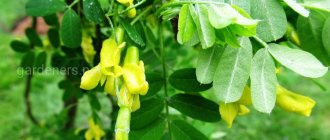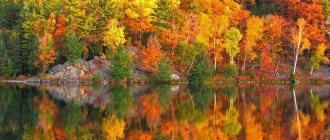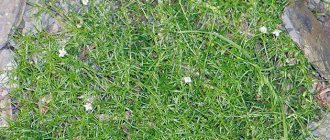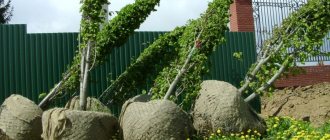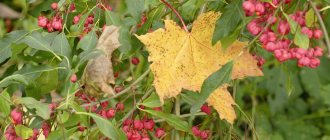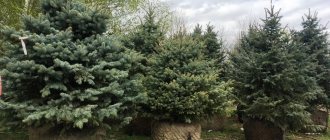In order to make a garden attractive, there are many types of garden decor, but living plants themselves can be decorative decorations. Ornamental plants are distinguished by the brightness and beauty of their flowers, the unusualness of their fruits and the color of their foliage. In summer, the main color of the garden is green; flowers always look great against this background. However, trees with leaves of a different color against the background of a green dominant look very impressive.
While everyone is accustomed to yellow autumn leaves, red ones invariably evoke admiration. There are much fewer trees whose leaves turn purple in autumn, and the red color in nature is one of the most beautiful and vibrant. When the flowers fade, the garden becomes empty, and this emptiness can be filled by ornamental trees and shrubs with leaves of unusual colors.
Barberry Admiration - burgundy and purple leaves with edging look no less impressive than bright autumn flowers, especially expressive in single compositions
- 2 Contender #2 – red maple
- 3 Contender #3 – elegant southern scumpia
- 4 Contender #4 – decorative apple tree
- 5 Contender #5 – red-leaved plum (cherry plum)
Contender #1 – bright, handsome barberry
Barberry is one of the most common shrubs for garden decoration. This is not surprising, since it is unpretentious and has wonderful decorative qualities.
Some varieties of this shrub have an unusual leaf color - burgundy (Thunberg barberry), while others turn bright red with the arrival of autumn. Ottawa barberry Auricoma is a shrub with purple-red leaves that turn red-orange in the fall.
Varieties of Thunberg barberry with green leaf edges. You can plant different types of shrubs on your site, in this case your garden will retain the beauty and brightness of colors until frost
Thanks to its excellent decorative properties, barberry is good everywhere - in single plantings, in groups with other plants and as a hedge. Shrubs don't need to be trimmed, but shaping and trimming them will make them look neater, especially in hedges.
A hedge of barberry bushes looks great against the backdrop of a lawn and gravel path, its maintenance is minimal, and the garden looks beautiful and neat
Barberry Thunberg and Ottawa are the most common. Conifers - Cossack juniper, thuja, pine - will be excellent “companions” for these shrubs. Barberry will form wonderful compositions in the fall in company with yellow deciduous shrubs.
Dwarf barberry seems to be created for miniature compositions - on the lawn, in a rocky garden, to create a mixborder or border. When planting a composition of several shrubs, it is desirable that the variety of forms be visible from everywhere.
When the barberry berries ripen, the foliage turns red and the bush looks doubly attractive, especially on a bright green lawn
Barberry is now sold in garden centers, so if you have chosen this pretty ornamental shrub, you can buy it without any problems.
The role of shrubs in the garden should not be underestimated. They make the garden look lived-in and cozy. Shrubs smooth out sharp edges well, and their beautiful leaves do not require constant care.
Six bushes with dark leaves
In modern garden design, shrubs with dark foliage are increasingly appearing - purple, red, burgundy, brown, violet and almost black for some garden styles. These shrubs have an amazing appeal - their foliage immediately attracts attention and literally fascinates, giving both brightness and depth to the greenery and flowers surrounding them. And if for some reason there is a pause in flowering in your garden, they will come to the rescue in maintaining the color scheme - elegant, bright, mysterious, and your garden will never be boring.
This is interesting: Hair care after keratin straightening 2019
Physocarpus opulifolius
Viburnum foliage is an unpretentious winter-hardy plant with large beautiful leaves. The color of popular varieties is dark purple with a violet or brown tint. Even the names of some of them, for example Litlle Devil, will be appreciated by lovers of the noir style (from the French Noir, “black”).
The most popular variety Diabolo, the second name is Purpureus, is also often translated as “Devil's Purple”. The shrub is large in size; if not trimmed, it can grow up to 3 m. However, do not be alarmed - a neatly trimmed shrub surrounded by greenery and warm-colored flowers turns into a bright, sophisticated accent plant that completely transforms the design of your garden.
The assortment also includes varieties with leaves of a more joyful purple-red (Lady in Red, Red Baron) or orange-red (Diabolo d'Or) color. These are low-growing varieties, so they can be used to decorate mixborders and alpine slides.
Contender #2 – red maple
This type of maple is widely used in landscape design. Trees with red foliage are native to southeast Asia and northeastern Canada. The Japanese have been breeding red-leaved maple varieties for centuries. Tree seedlings are now sold in nurseries. The red maple, in addition to having purple leaves in autumn, has a beautiful crown shape. Depending on the variety, it can be columnar or round, ovoid. Thanks to the subtle pattern of the leaves, the crown looks openwork.
A red maple tree is blazing against the backdrop of a golden autumn garden - a breathtaking and very beautiful sight. You can try to create something similar in your garden
The palm-shaped Japanese maple is a miniature tree with an openwork foliage pattern. It will look great in a Japanese garden, in compositions with large boulders. Sometimes it is grown in tubs that can be moved to different places
The most beautiful, spectacular types of Japanese maple:
- Acer palmatum – fan-shaped (palm-shaped);
- Acer shirasawanum – Shirasawa maple;
- Acer japonicum - Japanese red maple.
A tree with red foliage looks beautiful in any planting - both group and single. Red maple is vulnerable to direct sunlight and is best planted in light shade rather than in an open area.
These trees can decorate a patio and look good in groups with dark conifers. Since the red maple is an oriental guest in our gardens, it is an ideal tree for decorating an Asian-style garden. Under the umbrella crown of the tree you can plant flowers that grow well in shade and partial shade.
Recent Entries
Lilac perennials that are beautiful, compact and do not crowd out other plants Why when buying seedlings you should not take the sellers’ word for it and how to determine the age of the plant using 3 signs Tomato seedlings have turned purple or whitish: why the color has changed and how to save the plants
Red Sunset maple. Mature trees in a small group planting have grown well and decorate the front lawn
The buds of the red maple are large and bright red; the tree is very beautiful even during bud bloom, so its decorative qualities are manifested not only in autumn.
Bagatelle
Dwarf shrubs with red leaves are unusually good. An example of this is Bagatelle. Its height is about forty centimeters, while the diameter of the crown can reach a meter. The annual increase in width and height is about three centimeters.
These unpretentious shrubs have a fairly dense crown. The leaves are ovoid, no more than one and a half centimeters long, dark red. In autumn they turn carmine red.
It blooms in May with yellow-red small flowers collected in beautiful clusters. The fruits are bright red, shiny, up to a centimeter in size. As a rule, they ripen in early October.
It is undemanding to soil and tolerates short-term drought well. Used in rockeries, ridges, group plantings, rock gardens, borders.
Contender #3 – elegant southern scumpia
Mackerel grows naturally in regions with a fairly warm climate - in the Crimea, the Caucasus, southern Russia, and on the Mediterranean coast. With the onset of autumn, the leaves of this tall shrub turn burgundy, orange or purple (the color depends on the variety of mackerel). First, the veins turn red, and then the leaf turns bright color.
Mackerel has very beautiful leaves and inflorescences in the form of pink fluffy panicles, which can be used to create various compositions
In central Russia, mackerel has taken root well and is widely used as an ornamental plant. It is good in both single and group plantings and forms luxurious hedges. The shrub loves sunny meadows, protected from the wind. Mackerel is hardy, disease resistant, and pests rarely attack this shrub. Decorative qualities can be enhanced by starting to form a bush.
Our most common varieties of scumpia are:
- Flame;
- Purpureus;
- Grace.
Royal Purper is popular in Europe, but may freeze in colder climates.
If you have slopes or rocky soils on your site, the mackerel will take root well on them and will decorate your garden at any time of the year. In addition to the beautiful color of the foliage in autumn, it is beautiful during flowering - the inflorescences form pink fluffy panicles, making the shrub elegant and attractive.
A hedge of flowering mackerel with lilac leaves is a decoration for the site and a way to hide unsightly buildings
If you decide to decorate your garden with mackerel, keep in mind that it grows well, so it needs space. A small seedling will eventually become a luxurious spreading bush or small tree.
Contender #4 – decorative apple tree
The beauty of an ornamental apple tree can be compared with sakura - it is beautiful during the flowering period, when it is dotted with many pink flowers, and when the apples turn red and harmonize with the color of the foliage, this small tree looks no less magnificent.
The crown of a blooming decorative apple tree shot from above. As a rule, this tree has a rounded crown that does not require shaping. An apple tree blooming with pink or lilac flowers is like a princess in your garden.
An ornamental apple tree with red leaves is especially good in single plantings, when all attention is directed to its beauty, but several trees planted along the path, near the fence, look great. A tree will help to place the necessary accents in the garden and highlight even a shaded corner. There are no complaints about recoil at all.
One of the remarkable properties of the ornamental apple tree is its unpretentiousness and resistance to adverse atmospheric factors. It is not afraid of severe frosts, so it can be grown in rather harsh climates.
The fruits in combination with the leaves look very harmonious, bright, and they are also quite tasty. Living garden decor in autumn and spring
There are many varieties of this tree, which can take a central place in the garden composition on your site. The color of the leaves and petals can be different, the same can be said about the shape of the crown, so if you choose a decorative apple tree, study all the varieties and varieties of the tree.
Atropurpurea Nana
This is perhaps Thunberg's most popular barberry. A miniature shrub with red leaves, the height of which does not exceed sixty centimeters. Its crown is compact, flat-round. Differs in rather slow growth. It blooms with beautiful flowers: they are yellow inside and bright red outside, forming racemose inflorescences. Bright red fruits remain on the branches throughout the winter.
The leaves are small, at first they are dark red (almost black) in color, then become rich red. In autumn they turn bright red. The plant is undemanding to soil and has proven itself well in urban environments.
Contender #5 – red-leaved plum (cherry plum)
Red-leaved plum is another unpretentious tree that can be successfully used in garden landscape design. It has dark burgundy leaves and fruits of the same color. The tree also bears fruit well. The red-leaved plum lends itself well to shaping - you can form a spherical crown, it is good both as a free-growing tree and as a hedge. The height of the hedge can be any - from quite high (2 m and above) to 60-70 centimeters. Such a hedge can be an excellent decoration and hide your area from prying eyes. Like the ornamental apple tree, the plum tree is resistant to diseases and pests.
If you want to create a truly original garden on your property and are fond of ornamental plants, be sure to pay attention to red-leaved trees and shrubs. Both in summer and autumn they will help you place the right accents in the garden and create wonderful compositions. The area will look brighter and more elegant at any time of the year, with the exception of winter cold. And fruit plants with decorative foliage - plum, apple tree, barberry - will also delight you with delicious fruits by autumn.
- Author: sunflower12
Rate this article:
- 5
- 4
- 3
- 2
- 1
(20 votes, average: 4.2 out of 5)
Share with your friends!
Agrotechnical requirements and cultivation features
Most varieties of ornamental apple trees are not difficult to grow. Although a sunny position is absolutely necessary for a lush crown and normal growth and fruiting, the tree is relatively unpretentious in relation to soil conditions. However, it grows best in fertile, moderately moist soil with humus and a slightly acidic pH. It does not like alkaline, waterlogged and heavy soils, so you should avoid planting it in such places. The tree is quite resistant to low temperatures. It also tolerates short-term drought and air pollution in urban environments, making it ideal for planting in parks and gardens throughout the city. Due to its moderate growth vigor and compact crown, it does not require intensive pruning; you can limit yourself to only sanitary pruning of damaged and diseased shoots.
